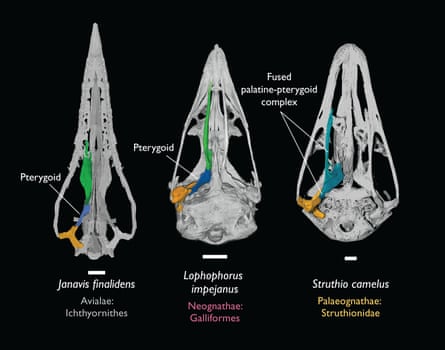CT scans of toothed bird fossil leads to jaw-dropping discovery | Fossils
Fossil experts have cooked the goose of a key tenet in avian evolution after finding a premodern bird from more than 65m years ago that could move its beak like modern fowl.
The toothy animal was discovered in the 1990s by an amateur fossil collector at a quarry in Belgium and dates to about 66.7m years ago – shortly before the asteroid strike that wiped out non-avian dinosaurs.
While the fossil was first described in a study about 20 years ago, researchers re-examining the specimen say they have made an unexpected discovery: the animal had a mobile palate.
“If you imagine how we open our mouths, the only thing we’re able to do is [move] our lower jaw. Our upper jaw is totally fused to our skull – it’s completely immobile,” said Dr Daniel Field, senior author of the research from the University of Cambridge.
Non-avian dinosaurs, including tyrannosaurs, also had a fused palate, as do a small number of modern birds such as ostriches and and cassowaries. By contrast, the vast majority of modern birds including chickens, ducks and parrots are able to move both their lower and upper jaw independently from the rest of the skull and each other.
That, says Field, makes the beak more flexible and dextrous, helping with preening, nest building and finding food. “That is a really important innovation in the evolutionary history of birds. But it was always thought to be a relatively recent innovation,” he said.
“The assumption has always been … that the ancestral condition for all modern birds was this fused-up condition typified by ostriches and their relatives just because it seems simpler and more reminiscent of non-bird reptiles,” Field added.
Birds with a mobile palate are called neognaths, or “new jaws”, while those with a fused palate are palaeognaths, or “old jaws”.
The study, which was published in the journal Nature, is expected to ruffle feathers, not only for suggesting the mobile palate predates the origin of modern birds but that the immediate ancestors of ostriches and their relatives went on to evolve a fused palate.
“Why the ancestors of ostriches and their relatives would have lost that beneficial conformation of the palette is, at this point, still a mystery to me,” said Field.
The discovery was made when Field and colleagues examined the fossils using CT scanning techniques. The researchers discovered that a bone previously thought to be from the animal’s shoulder was actually from its palate.

The team have labelled the newly discovered animal Janavis finalidens in reference to the Roman god that looked both backwards and forwards, and a nod to the animal’s place on the bird family tree. The portmanteau of the Latin words for “final” and “teeth” reflects the existence of Janavis shortly before toothed birds were wiped out in the subsequent mass extinction.
The site of its discovery means it lived around the same time and place as the toothless “wonderchicken”, the oldest known modern bird, although at 1.5kg (3.3lb), Janavis would have have weighed…
Read More: CT scans of toothed bird fossil leads to jaw-dropping discovery | Fossils
